Data Sensing and Processing Tensioning System Based on the Internet of Things
Abstract
:1. Introduction
- Investigated the technical framework and techniques of a system and designs a work flow of sensing, transport, and application service layers to realize collection and quality monitoring of tensioning process data, and proposed the architecture of the intelligent tensioning system.
- Proposed a data acquisition and preprocessing method for the sensing layer, put forward the data-pushing mechanism of the transport layer, and designed the function and work flow of the application service layer.
- Implemented the intelligent tensioning system based on browser/server (B/S) architecture and APP mobile terminals by using .NET platform and Android Studio.
2. Technical Framework and Analysis
2.1. IoT Sensing Layer
2.2. Transport Layer
2.3. Application Service Layer
3. Intelligent Tensioning System Design
3.1. Operation Flow
3.2. Data Encapsulation
3.3. Pushing and Receiving
3.3.1. Transport Mechanism
3.3.2. Transport Flow
3.4. Data Processing
| Algorithm 1: Algorithm for data merging |
| 1: Begin 2: d ← getDataPaket() // get packets 3: if(IsFlag1(d)) { // judge if it is Flag packet 1 Initialize queue S; Initialize arrayA,U; goto step 2; } 4: if(IsConclusion(d)){ put d into queue S; // the operation of enqueue goto step 2; } 5:if(IsFlag2(d)) { // Insert the data in Flag Packet 2 t ← getType(d); // get job type if(t=TypeA or t=TypeB) { A[i++] ← get first flag information from d; } if(t=TypeA or t=TypeC) { A[i++] ← get second flag information from d; } } 6: while S is not null //MergeData(d,h) { h ← get data from queue S; t ← getType(h);// get job type if(t=TypeA or t=TypeB) { U[j++] ← get first conclusion from h; } if(t=TypeA or t=TypeC) { U[j++] ← get second conclusion from h; } U[j++] ← get other operating data; delete h from queue S; } 7:execute instruction from arrays A and U; 8:End |
3.5. Application Layer
4. System Implementation
5. Case Study and Analysis
5.1. Equipment Parameters
5.2. Application Display and Analysis
5.2.1. Remote Monitoring
5.2.2. Abnormal Warning and Conclusion Analysis
5.2.3. Job Statistics Analysis
6. Conclusions
Author Contributions
Funding
Conflicts of Interest
References
- Guo, T.; Chen, Z.; Liu, T. Time-dependent reliability of strengthened PSC box-girder bridge using phased and incremental static analyses. Eng. Struct. 2016, 117, 358–371. [Google Scholar] [CrossRef]
- Otero-Chans, D.; Estévez-Cimadevila, J.; Martín-Gutiérrez, E. Application of a New System of Self-Tensioning to the Design of Large-Span Wood Floor Framings. J. Struct. Eng. 2016, 142, 04016012. [Google Scholar] [CrossRef]
- Qian, K.; Yang, T.; Li, B. Progressive Collapse Resistance of Prestressed Concrete Beam-Column Sub-assemblages with Unbonded Post-Tensioning Strands. J. Struct. Eng. 2018, 144. [Google Scholar] [CrossRef]
- Gosaye, J.; Gardner, L.; Wadee, M.A. Tensile performance of prestressed steel elements. Eng. Struct. 2014, 79, 234–243. [Google Scholar] [CrossRef]
- Oh, B.H.; Si, N.L.; Lee, M.K. Analysis and Prediction of Transfer Length in Pretensioned, Prestressed Concrete Members. ACI Struct. J. 2014, 111, 549–560. [Google Scholar] [CrossRef]
- Cowan, H.J. The strength of plain, reinforced and prestressed concrete under the action of combined stresses, with particular reference to the combined bending and torsion of rectangular sections. Mag. Concr. Res. 2015, 5, 75–86. [Google Scholar] [CrossRef]
- Iqbal, M.A.; Rajput, A.; Gupta, N.K. Performance of prestressed concrete targets against projectile impact. Int. J. Impact Eng. 2016, 110, 15–25. [Google Scholar] [CrossRef]
- Lachowicz, M.; Nagrodzka-Godycka, K. Experimental study of the post tensioned prestressed concrete corbels. Eng. Struct. 2016, 108, 1–11. [Google Scholar] [CrossRef]
- Liao, M.; Ding, X.; Wen, X. Intelligent Stretching of Prestressed Precast Box Girder of Highway and Grouting Construction Technology. Constr. Technol. 2016, s2, 343–345. [Google Scholar]
- Dong, X.; Yu, X. Application of Prestressed Intelligent Tensioning System in Prefabricated Box Girder. Highway 2013, 9, 113–115. [Google Scholar]
- Liang, X.D. Development of Intelligent Synchronous Prestress Tension System. J. China Foreign Highw. 2013, 33, 106–108. [Google Scholar]
- Xiao, Y.; Zhang, T.; Chen, Y. Intelligent Tension Equipment Calibrating System. CN 203629866 U, 4 June 2014. [Google Scholar]
- Yang, Q.; Chen, X. Intelligent tension large circulation grouting construction technology. Highway 2014, 7, 188–191. [Google Scholar]
- Xiong, X. Development and Application of Prestressed Intelligent Tensioning Technology Based on Internet of Things. Constr. Technol. 2015, 44, 55–59. [Google Scholar]
- Yao, X.; YU, M.; Chen, Y. Connotation, architecture and key technologies of Internet of manufacturing things. Comput. Integr. Manuf. Syst. 2014, 20, 1–10. (In Chinese) [Google Scholar]
- Hou, R.; Ding, X.; Tao, Y. Internet of manufacturing things and relevant technical architecture. Comput. Integr. Manuf. Syst. 2014, 20, 11–20. (In Chinese) [Google Scholar]
- Yang, J.J.; Fu, C.H.; Dong, Z.Q. Research and Design of Remote Surveillance System Based on the Internet of Things. Adv. Mater. Res. 2014, 889–890, 671–675. [Google Scholar] [CrossRef]
- Yang, G.C.; Li, S.B.; Hu, Y. Project Image Progress Parametric Generating System for Railway Engineering. J. Wuhan Univ. Technol. Transport. Sci. Eng. 2009, 33, 246–249. [Google Scholar]
- Zhan, C.; Fan, Y. Complex event processing of real time enterprises based on smart items. Chin. J. Mech. Eng. 2007, 43, 22–32. [Google Scholar]
- Lu, Y.J.; Cecil, J. An Internet of Things (IoT)-based collaborative framework for advanced manufacturing. Int. J. Adv. Manuf. Technol. 2016, 84, 1141–1152. [Google Scholar] [CrossRef]
- Zhang, Y.; Zhang, G.; Wang, J. Real-time information capturing and integration framework of the internet of manufacturing things. Appl. Mech. Mater. 2015, 121–126, 4059–4063. [Google Scholar] [CrossRef]
- Zhao, X.; Zhang, Y.; Sun, S.; Wang, J.; Si, S. Implementing method and key technology for IoT-based manufacturing execution system. Comput. Integr. Manuf. Syst. 2012, 18, 2634–2642. [Google Scholar]
- Tao, F.; Zuo, Y.; Xu, L.D. IoT-Based Intelligent Perception and Access of Manufacturing Resource toward Cloud Manufacturing. IEEE Trans. Ind. Inform. 2014, 10, 1547–1557. [Google Scholar]
- Chen, W.; Li, S.; Huang, H. Active perception and management model for manufacturing data in discrete IoMT-based process. Comput. Integr. Manuf. Syst. 2016, 22, 166–176. [Google Scholar]
- Huang, G.Q.; Zhang, Y.F.; Jiang, P.Y. RFID-based wireless manufacturing for real-time management of job shop WIP inventories. Int. J. Adv. Manuf. Technol. 2008, 36, 752–764. [Google Scholar] [CrossRef]
- Li, X.; Gao, H.; Qiao, Y. Real-time Complex Event Processing Engine in Internet of Things. J. Chin. Comput. Syst. 2015, 36, 2047–2052. [Google Scholar]
- Li, S.; Chen, W.; Hu, J. ASPIE: A Framework for Active Sensing and Processing of Complex Events in the Internet of Manufacturing Things. Sustainability 2018, 10, 692. [Google Scholar] [CrossRef]
- Akl, A.; Saiidi, M.S.; Vosooghi, A. Deflection of in-span hinges in prestressed concrete box girder bridges during construction. Eng. Struct. 2017, 131, 293–310. [Google Scholar] [CrossRef]
- Islam, M.S.; Lee, J.C.; Chong, U. Design and implementation of an automated monitoring system. J. Supercomput. 2016, 72, 4247–4261. [Google Scholar] [CrossRef]
- Lian, J.H.; Hui-Min, L.I.; Sun, K. Design of Poultry Farming Environment Remote Monitoring System Based on Internet of Things. Poultry Sci. 2015, 7, 7–10. [Google Scholar]
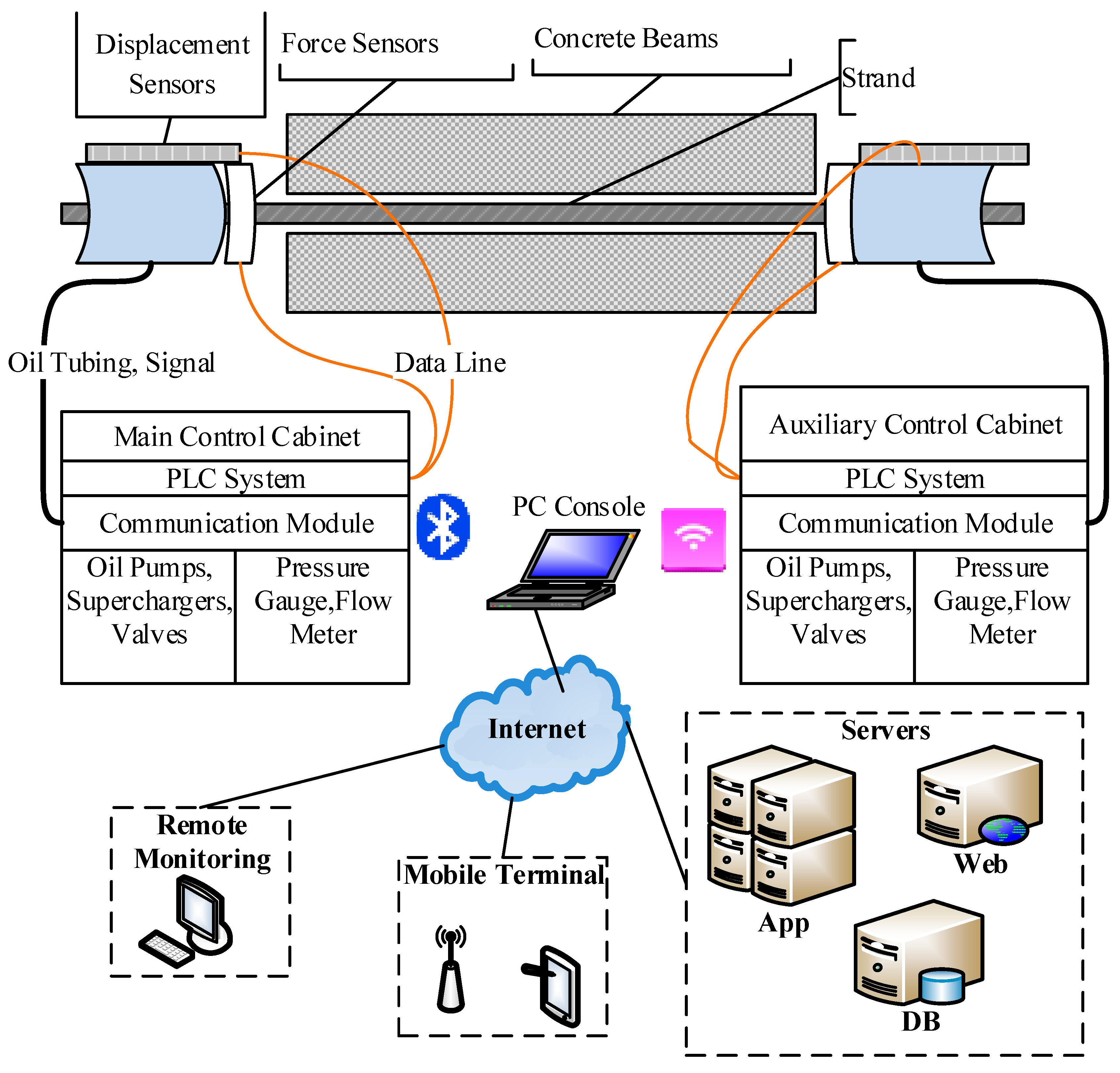
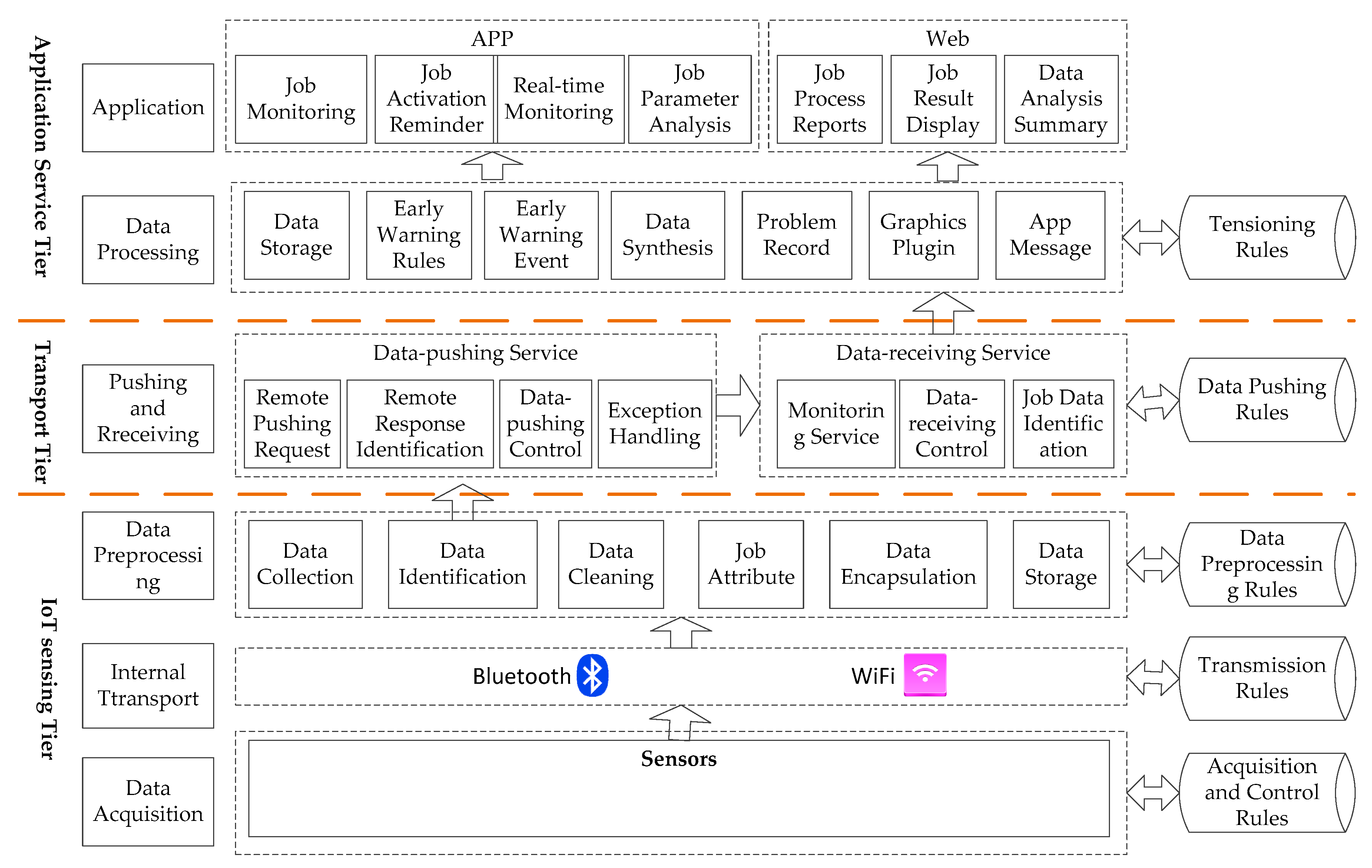
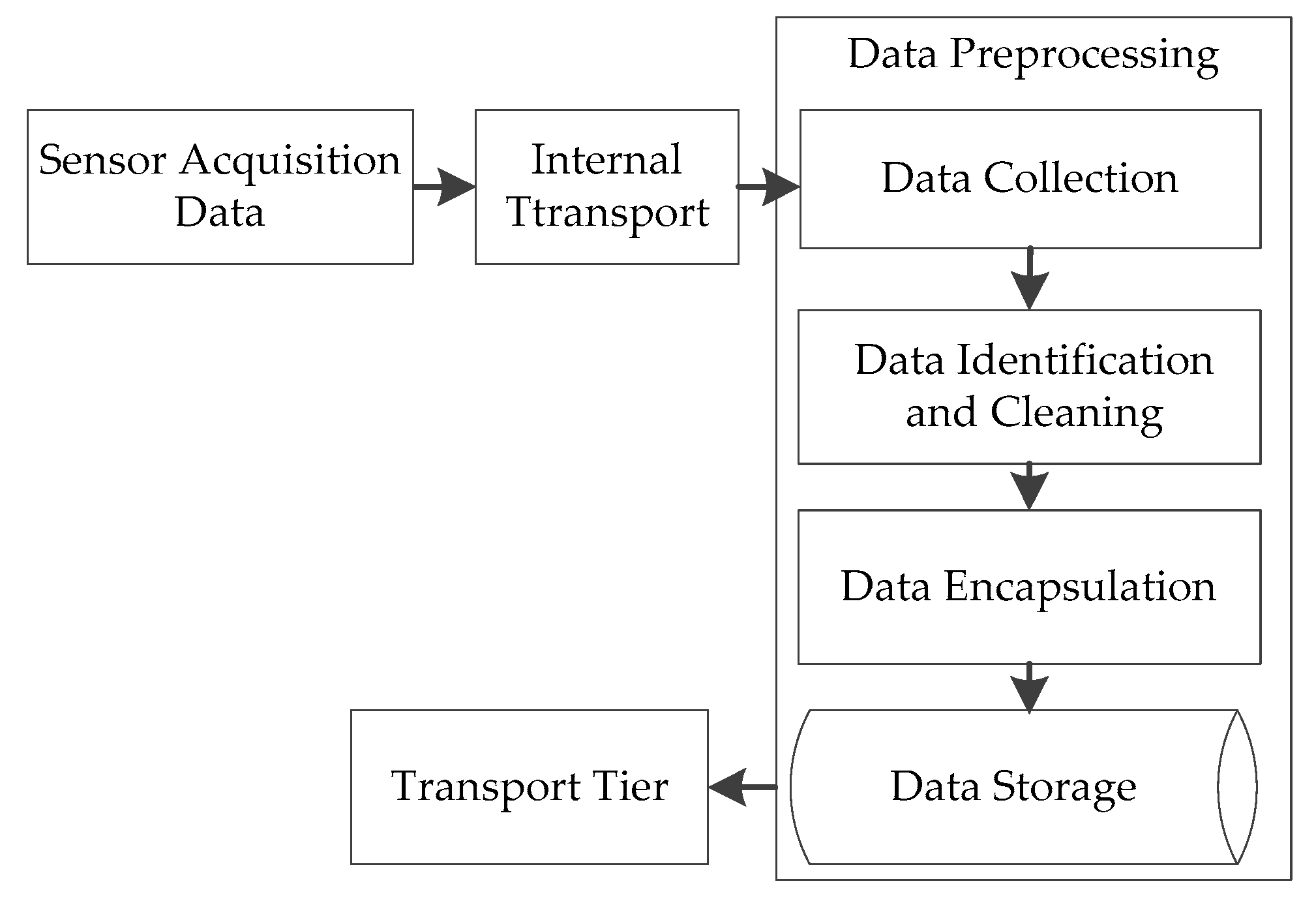



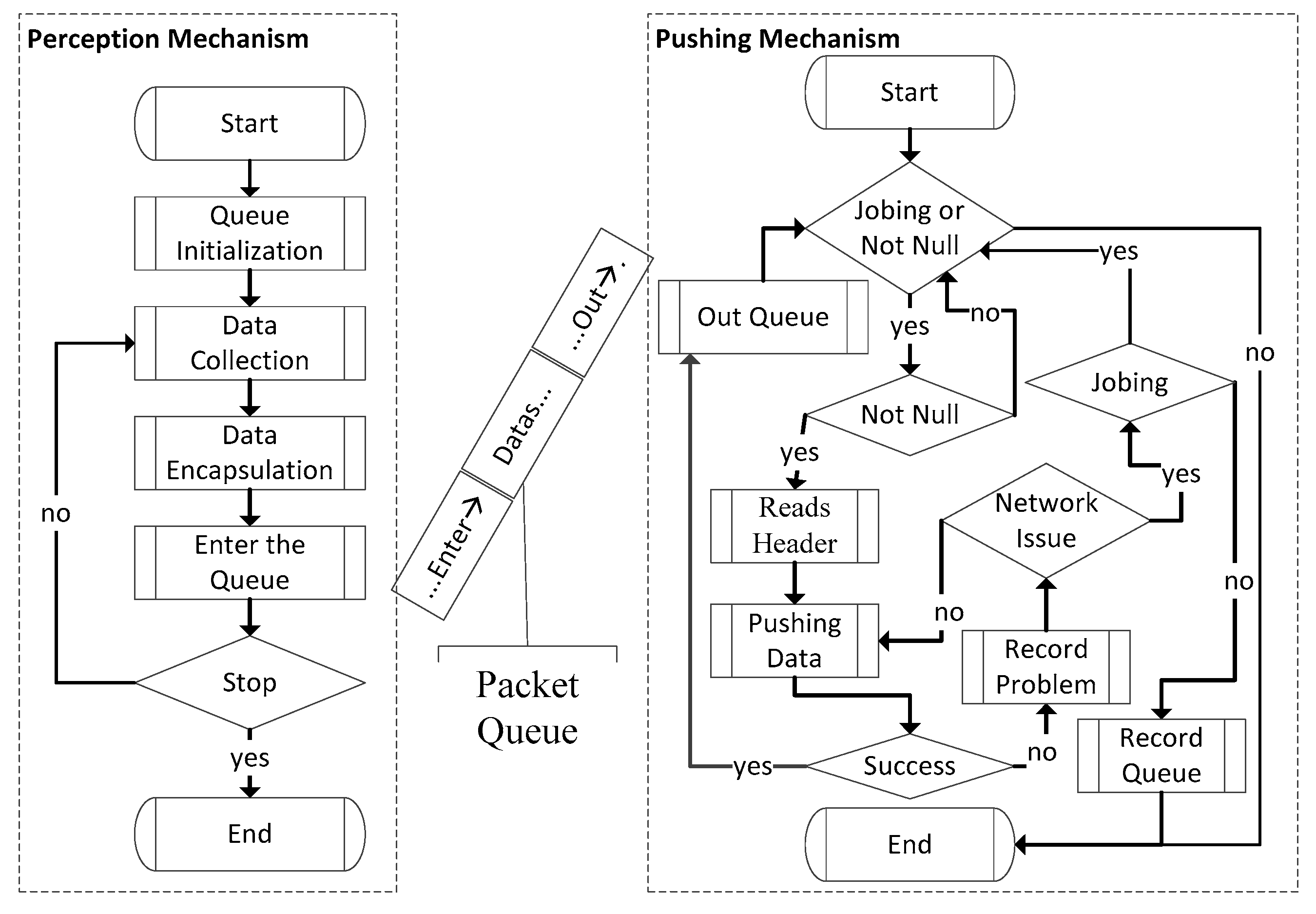
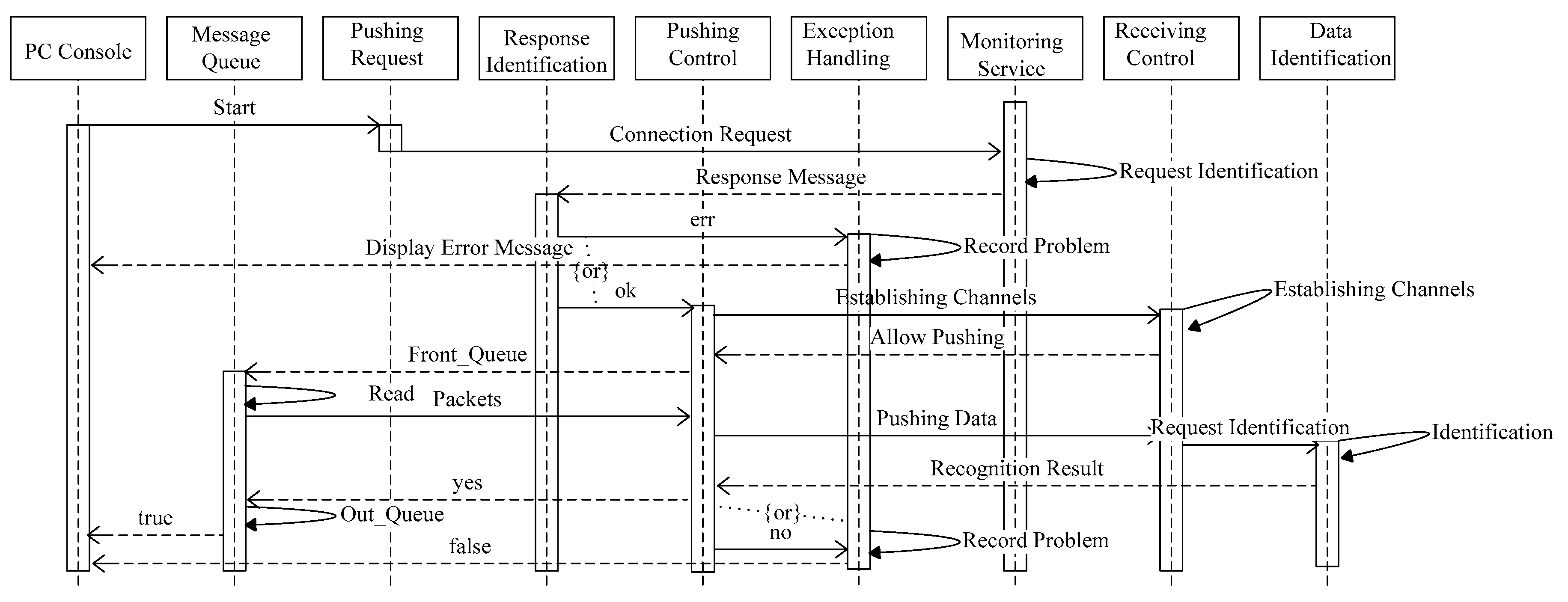
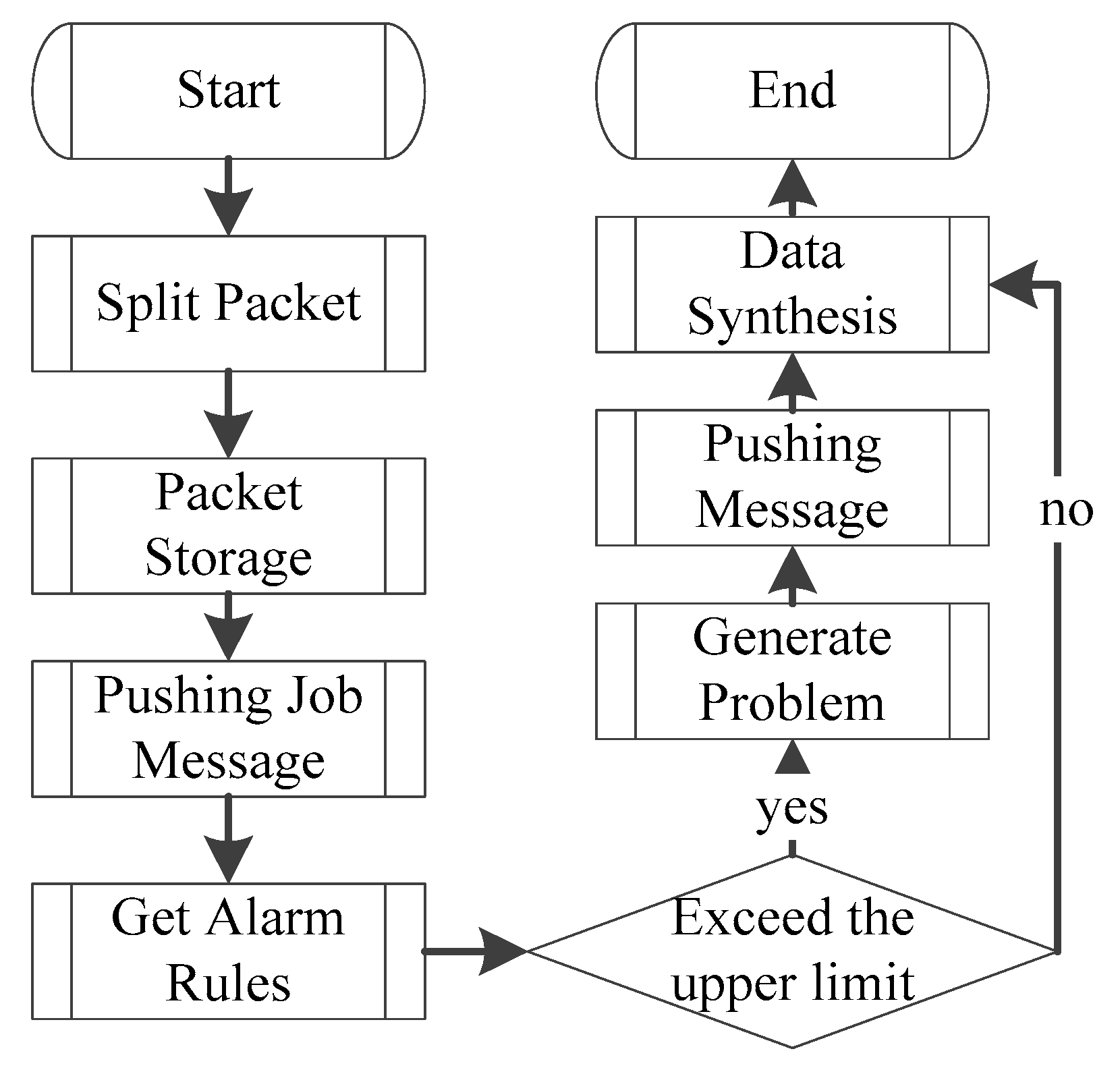
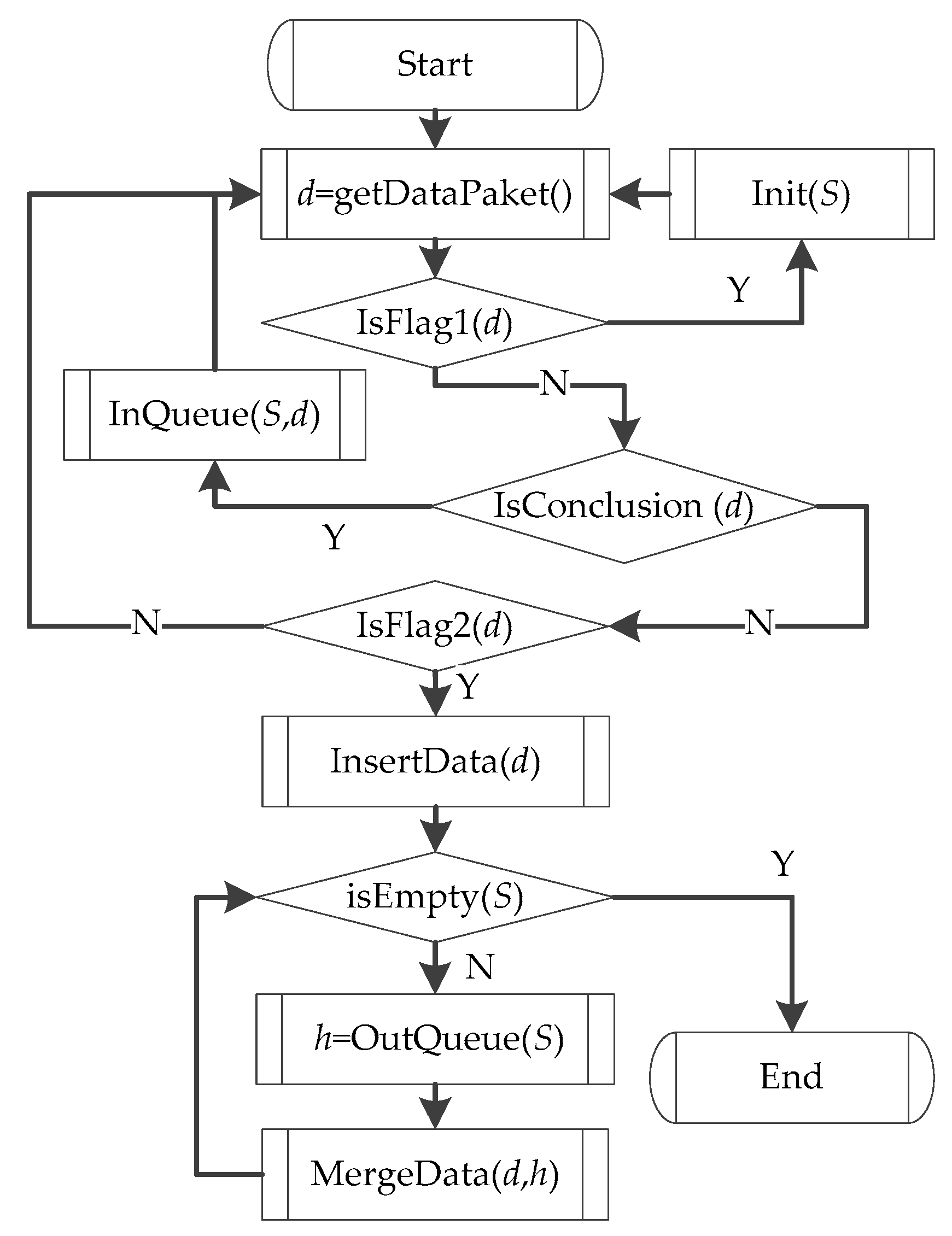
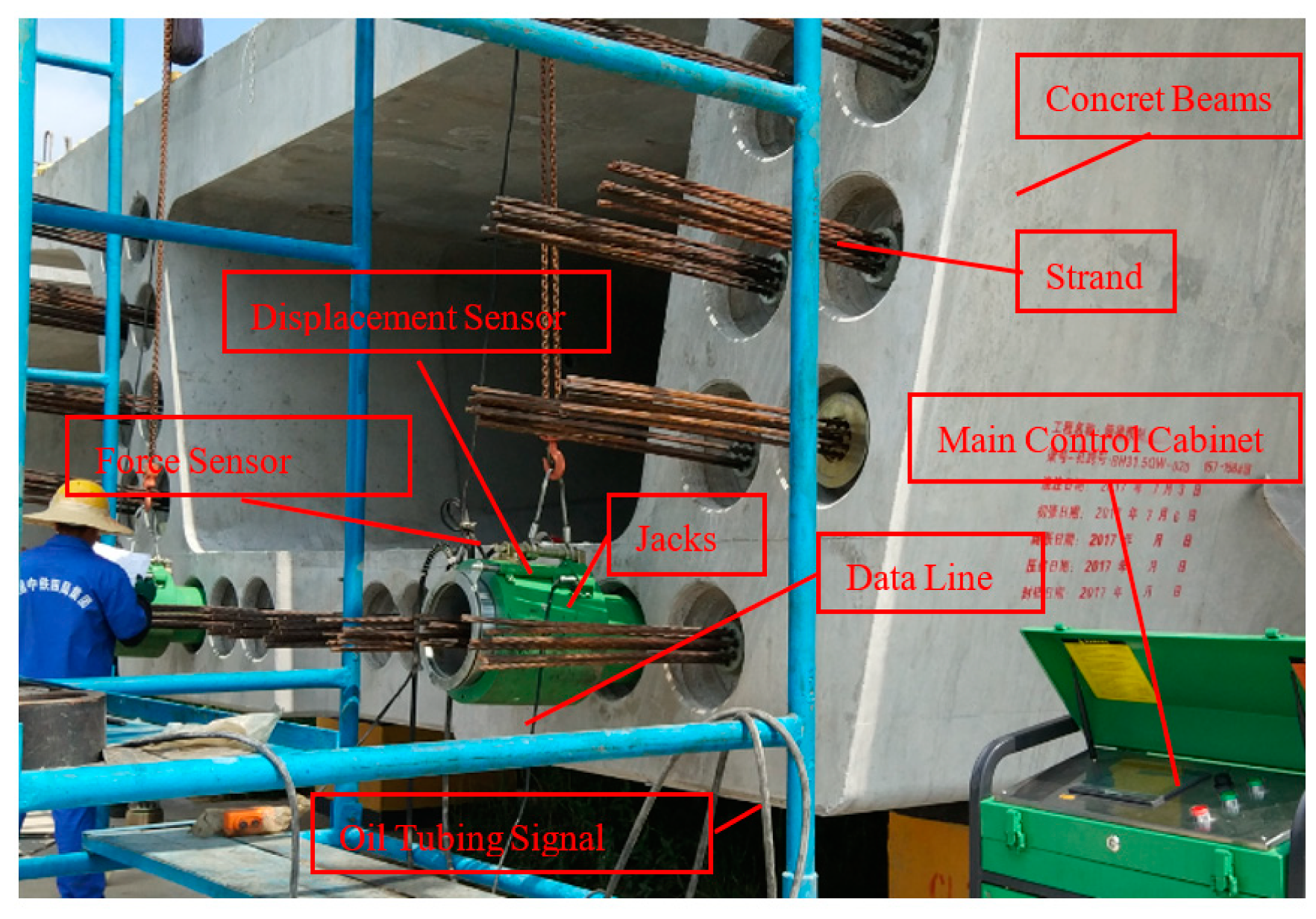
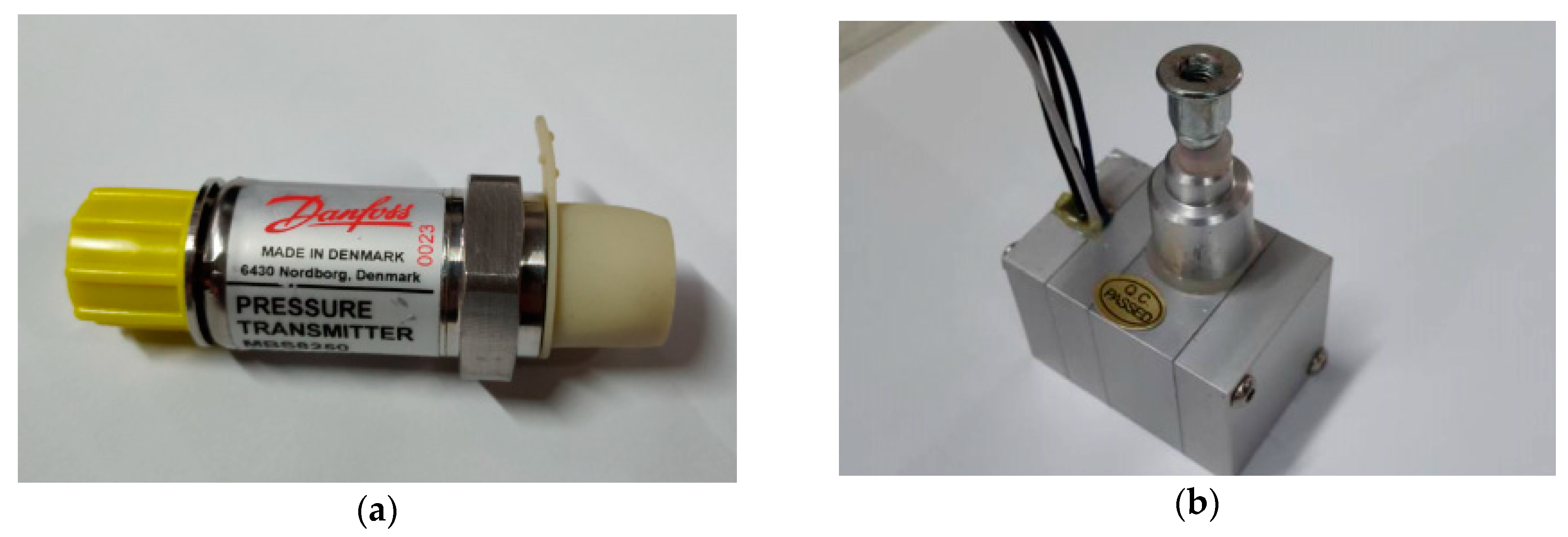

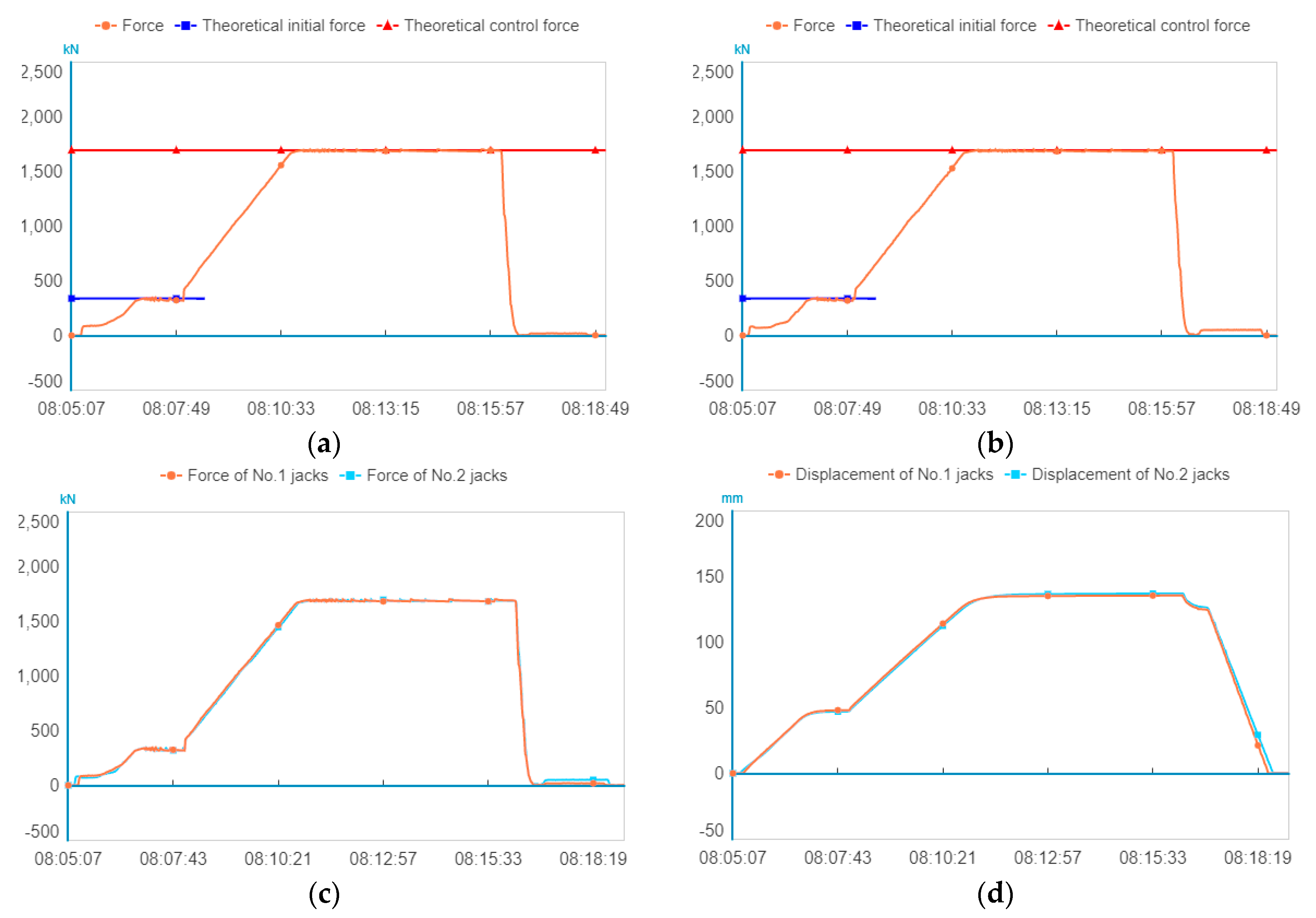
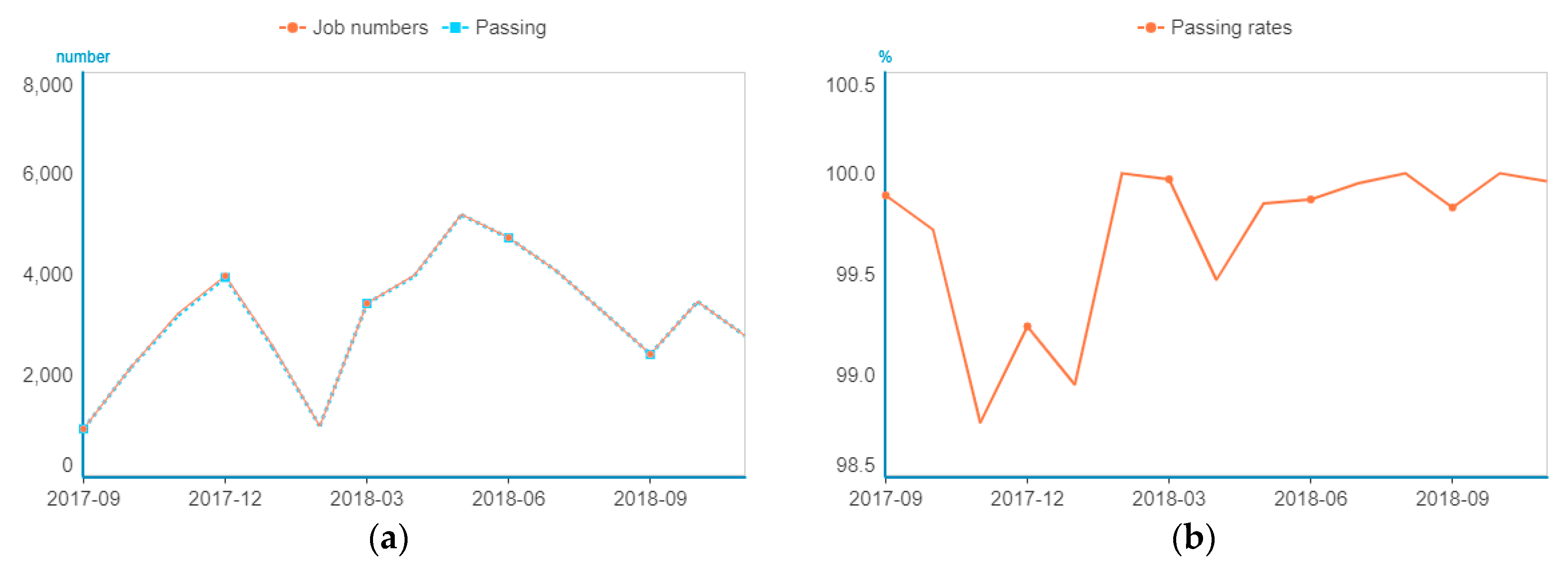
| No. | Data Block Name | Field | ||
|---|---|---|---|---|
| Name | Byte | Remarks | ||
| 1 | Packet header | Header | 4 | |
| Device ID | 10 | Device ID uniquely identifies each device | ||
| 2 | Job number | Job number | 13 | E.g.: AA-BBBB-CCCCC |
| 3 | Data length | Data length | 2 | |
| 4 | Data type | Data type | 1 | The range of values is flag, conclusion, and process. |
| 5 | Job data | Tensioning mode | 1 | The values range from 1 to 9. |
| Tensioning progress | 1 | The values range from 1 to 5. | ||
| Tensioning time | 6 | Binary-coded decimal (BCD) E.g.: “181020154341” means the current time is 15:43:41 on 20 October 2018. | ||
| No. 1 channel | 8 | |||
| Force of No. 1 jacks | 4 | |||
| Displacement of No. 1 jacks | 2 | |||
| Force of No. 2 jacks | 4 | |||
| Displacement of No. 2 jacks | 2 | |||
| No. 2 channel | 8 | |||
| Force of No. 3 jacks | 4 | |||
| Displacement of No. 3 jacks | 2 | |||
| Force of No. 4 jacks | 4 | |||
| Displacement of No. 4 jacks | 2 | |||
| 6 | Check bit | Check bit | 2 | Cyclic Redundancy Check (CRC) |
| No. | Function Name | Description |
|---|---|---|
| 1 | Job reminder | When a tensioning job is detected on-site, a job message is pushed to the app in time, and the job monitoring is automatically started via the job message. |
| 2 | Job monitoring | The job data pushed on-site are monitored in time, and a job list is monitored. |
| 3 | Remote monitoring | Certain job data are monitored in time, and the process data and changing trends of force and displacement are shown with continuous curves. |
| 4 | Job analysis | Changes in force and displacement during tensioning operations are analyzed. |
| No. | Function Name | Description |
|---|---|---|
| 1 | Job reports | A construction record chart of tensioning job data is automatically generated to record the job data of each beam channel. |
| 2 | Job results | (1) The results of various tensioning operations are displayed, and detailed operation information of each channel is shown. (2) Tensioning and displacement at both ends are analyzed. (3) Trend analysis of tensioning force and displacement at the same end is conducted. (4) Contrastive analysis between the designed initial stress and the actual tensioning force is performed, and the duration when they match with each other is determined. (5) Contrastive analysis between the designed control stress and the actual tensioning force is conducted, and the duration when they match with each other is identified. |
| 3 | Analysis summary | (1) The work amounts, normal amounts, normal rates, and other information are shown by curves in units of months. (2) Normal and abnormal ratios are obtained. (3) Normal and abnormal ratios of tensioning force are calculated. (4) Normal and abnormal ratios of displacement are acquired. |
| No. | Equipment | Parameter Requirements | Quantity |
|---|---|---|---|
| 1 | Jacks | 4 | |
| 2 | Force sensor | The error is less than 0.5%FS. | 4 |
| 3 | Displacement sensor | The error is less than 0.25%FS. | 4 |
| 4 | Communication module | The data transport from sensors to PC console is supported, and wireless transmission distance is not less than 200 m | 1 |
| 5 | PC control machine | Ordinary PC or notebook, with Win7 system, is utilized. Data-pushing service is installed. | 1 |
| 6 | Mobile communication terminal | Support 4G network. | 1 |
| No. | Channel | Force (kN) | Displacement (mm) | Deviation (%) | ||||||
|---|---|---|---|---|---|---|---|---|---|---|
| Initial | Control | Initial | Control | Calcula-Tive | Theore-Tical | |||||
| No. 1 Jacks | No. 2 Jacks | No. 1 Jacks | No. 2 Jacks | |||||||
| 1 | ZN8 | 338.8 | 1694.1 | 48.2 | 47.1 | 135.6 | 137.1 | 208.4 | 198.4 | 5.0 |
| 2 | YN8 | 338.8 | 1694.1 | 49.5 | 47.4 | 137.5 | 128.7 | 198.2 | 198.4 | −0.1 |
| 3 | ZN9 | 345.6 | 1728.2 | 49.0 | 47.8 | 135.3 | 134.9 | 203.4 | 198.6 | 2.4 |
| 4 | YN9 | 345.6 | 1728.2 | 46.9 | 45.4 | 134.1 | 126.6 | 197.1 | 198.6 | −0.8 |
| 5 | ZN1a | 450.0 | 2249.9 | 44.2 | 44.6 | 129.3 | 132.7 | 203.1 | 198.4 | 2.8 |
| 6 | ZN2d | 1289.0 | 1687.4 | 35.3 | 37.4 | 63.9 | 65.8 | 199.4 | 201.4 | −1.0 |
| 7 | YN2d | 1289.0 | 1687.4 | 29.5 | 29.0 | 57.4 | 60.7 | 200.1 | 201.4 | −0.7 |
| 8 | ZN2a | 1289.0 | 1687.4 | 36.3 | 36.7 | 63.9 | 64.2 | 195.9 | 201.4 | −2.7 |
| 9 | YN2a | 1289.0 | 1687.4 | 33.0 | 32.5 | 62.3 | 56.8 | 195.5 | 201.4 | −2.9 |
| 10 | ZN5 | 345.6 | 1728.2 | 50.9 | 54.0 | 133.7 | 139.6 | 197.1 | 194.6 | 1.3 |
| No. | Comparison | Traditional Tensioning System | System in This Paper |
|---|---|---|---|
| 1 | Data authenticity | Managers cannot remotely monitor the tensioning operation, and cannot obtain the key control data during the tensioning operation in time. When an abnormality occurs during the tensioning process, the operator may tamper with the data and there is a risk of virtual data. | When tensioning devices are started, job messages are automatically pushed to the mobile terminal app. Job data during the process are monitored via mobile terminal apps or browsers at any time. The changing trends of tensioning and displacement are reflected through continuous curves. |
| 2 | Exception handling timeliness | When an anomaly occurs, the abnormal information is recorded on the site control engine and cannot be pushed to the administrator in time. It is difficult for administrators to find abnormal tension information in time and make timely decisions. | A problem base is generated automatically in accordance with the alert rules, and the abnormal information is pushed to the administrator’s mobile terminal apps to spot abnormal information in time. Administrators can make timely decisions based on abnormal information. |
| 3 | Fill in the data workload | The operator needs to manually record all kinds of key control data generated during the tensioning process, which increases the workload of the operator. | System automatically record various types of control data, and automatically generate various types of data reports according to application rules, avoiding manual filling of large amounts of data. |
| 4 | Viewing data convenience | Job data only can be checked on-site. | Historical job data can be viewed through mobile terminal apps or browsers. |
© 2019 by the authors. Licensee MDPI, Basel, Switzerland. This article is an open access article distributed under the terms and conditions of the Creative Commons Attribution (CC BY) license (http://creativecommons.org/licenses/by/4.0/).
Share and Cite
Chen, X.; Yang, G. Data Sensing and Processing Tensioning System Based on the Internet of Things. Appl. Sci. 2019, 9, 310. https://doi.org/10.3390/app9020310
Chen X, Yang G. Data Sensing and Processing Tensioning System Based on the Internet of Things. Applied Sciences. 2019; 9(2):310. https://doi.org/10.3390/app9020310
Chicago/Turabian StyleChen, Xiaowen, and Guanci Yang. 2019. "Data Sensing and Processing Tensioning System Based on the Internet of Things" Applied Sciences 9, no. 2: 310. https://doi.org/10.3390/app9020310
APA StyleChen, X., & Yang, G. (2019). Data Sensing and Processing Tensioning System Based on the Internet of Things. Applied Sciences, 9(2), 310. https://doi.org/10.3390/app9020310





